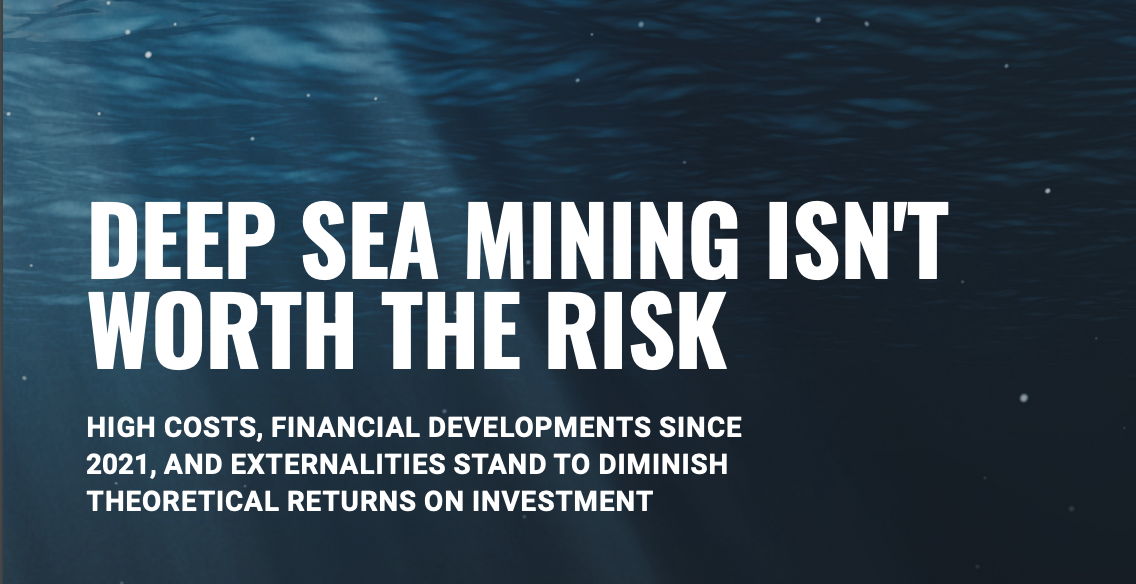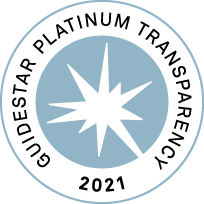Report finds extracting nodules lodged in the ocean floor is rife with technical challenges and overlooks rise of innovations that would eliminate the need for deep-seabed mining; warns investors to think twice before backing unproven industry
Get all the facts about the financial risks of deep seabed mining on one page:
WASHINGTON, D.C. (2024 February 29) – With the environmental risks of mining the deep sea already well documented, a new report provides the most comprehensive assessment to date of the extent to which the industry is economically viable, revealing its unrealistic financial models, technological challenges and poor market prospects that gravely undermine its potential for profit.
Released as the U.S. government considers engaging in deep-sea mining in domestic waters and in advance of a much-anticipated meeting of the International Seabed Authority (March 18-29) — the body tasked with regulating deep-sea mining in the international high seas — the study lays out the risks of investing in an unproven extractive industry gearing up to commercially produce a nonrenewable resource with unknown and increasingly apparent environmental, sociocultural and economic implications.
“When it comes to deep sea mining, investors should be on high alert and undertake robust due diligence,” said Bobbi-Jo Dobush of the Ocean Foundation and one of the authors of the report, Deep Seabed Mining Isn’t Worth the Financial Risk. “Trying to mine minerals from the ocean floor is an unproven industrial endeavor fraught with technical, financial, and regulatory uncertainty. More so, the industry faces strong Indigenous opposition and human rights concerns. All of these factors add up to substantial potential financial and legal risks for both public and private investors.”
One of the most concerning red flags, according to the report, is the industry’s unrealistically optimistic financial models that ignore the following:
- Major technical difficulties in extraction at unprecedented depths below the surface. In the fall of 2022, the first deep-sea mining (DSM) collection trial in international waters, done at a very small scale, had significant technological hitches. Observers have noted how difficult and unpredictable it is to operate in the ocean depths.
- A volatile minerals market. Frontrunners have built business plans on the assumption that demand for certain minerals that may be obtainable in the deep sea will continue to grow. However, metals prices have not risen in tandem with electric vehicle production: between 2016 and 2023 EV production is up 2,000% and cobalt prices are down 10%. A report commissioned by the International Seabed Authority (ISA) found that there is high uncertainty around prices for commercial metals once contractors begin production, leading to the possibility that relatively high-cost minerals from the seabed are not competitive and thus generate little or no profit.
- There would be a large upfront operational cost associated with DSM, on par with highly industrial extractive industries, including oil and gas. It is unreasonable to assume DSM projects would fare better than standard industrial projects, two-thirds of which go over budget by an average of 50%.
“Seabed minerals – nickel, cobalt, manganese, and copper – are not “a battery in a rock” as mining companies claim. Some of these minerals power last-generation technology for electric vehicle batteries but car makers are already finding better and safer ways to power batteries,” said Maddie Warner of The Ocean Foundation and one of the report’s lead authors. “Soon, innovations in battery power will likely sink demand for seabed minerals.”
Potential costs and liabilities are exacerbated by known and unknown threats in all aspects of DSM, making a return on investment uncertain. These threats include:
- Incomplete regulations at the national and international levels that, in their current draft form, anticipate robust costs and extreme liabilities. These include significant upfront financial guarantees/bonds, mandatory insurance requirements, strict liability for companies, and extremely long-term monitoring requirements.
- Reputational concerns associated with front-running DSM companies. Early-stage startups have not factored risk or actual damages from environmental spills or protests into their business plans, giving potential investors and decision-makers an incomplete picture. For example, when The Metals Company (TMC) was first listed on the U.S. stock exchange, civil society argued that its original filing did not sufficiently disclose risks; the Securities Exchange Commission agreed and required TMC to file an update.
- Ambiguity around who will pay for the cost of damage to ocean ecosystems.
- Misleading comparisons to terrestrial mining and overstated Environmental, Social, and Governance (ESG) claims.
Compounding all of these risks is the mounting international pressure to halt deep-sea mining. Currently, 24 countries have called for a ban, moratorium, or precautionary pause on the industry.
Increasingly, banks, financial institutions and insurers have also cast doubt on the industry’s viability. In July 2023, 37 financial institutions urged governments to pause deep seabed mining until the environmental, sociocultural, and economic risks are understood and alternatives to deep sea minerals have been explored.
“Significant challenges must be overcome before DSM can be recognized as economically viable or as a responsible industry that can make a positive economic contribution to society,” the statement says. Banks worldwide including Lloyds, NatWest, Standard Chartered, ABN Amro, and BBVA have also shunned the industry.
Additionally, 39 companies signed pledges not to invest in DSM, not allow mined minerals to enter their supply chains and not source minerals from the deep sea. These companies include Google, Samsung, Philips, Patagonia, BMW, Rivian, Volkswagen and Salesforce.
Swimming against the tide, some countries, such as Norway and the Cook Islands, have opened up their national waters to exploratory mining activities. The U.S. government was expected to release a report by March 1 assessing the industry’s viability domestically, while TMC has an application pending for US government funding to build a seabed minerals processing plant in Texas. Countries pursuing deep sea mining are increasingly isolated on the global stage. “As delegates prepare for the 29th Session of the International Seabed Authority (Part One), being held from 18-29 March 2024 in Kingston, Jamaica, this report offers guidance for how investors and government decision-makers can more comprehensively assess the financial risk of potential deep seabed mining operations,” said Mark. J. Spalding, President, The Ocean Foundation.
dsm-finance-brief-2024How to cite this report: Published by The Ocean Foundation. Authors: Bobbi-Jo Dobush and Maddie Warner. 29 February 2024. Special thanks to contributions and reviews from Neil Nathan, Kelly Wang, Martin Webeler, Andy Whitmore, and Victor Vescovo.
For more information:
Alec Caso ([email protected]; 310-488-5604)
Susan Tonassi ([email protected]; 202-716-9665)
About The Ocean Foundation
As the only community foundation for the ocean, The Ocean Foundation’s 501(c) (3) mission is to improve global ocean health, climate resilience, and the blue economy. We create partnerships to connect all peoples in the communities in which we work to the informational, technical, and financial resources they need to achieve their ocean stewardship goals. The Ocean Foundation executes core programmatic initiatives to make ocean science more equitable, advance blue resilience, address global marine plastic pollution, and develop ocean literacy for marine education leaders. It also fiscally hosts more than 55 projects across 25 countries.






